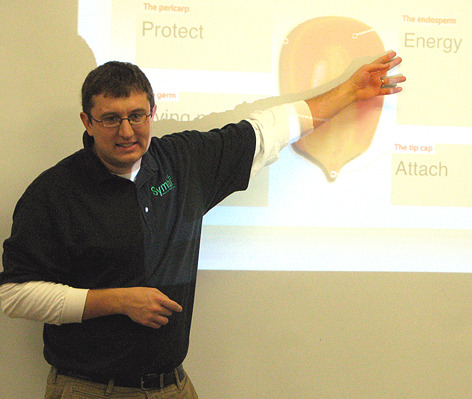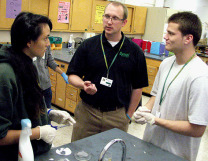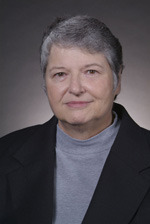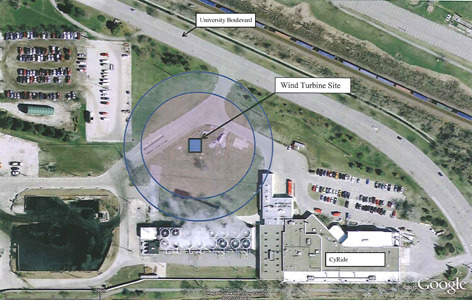High school and graduate students teach each other lessons in science

Iowa State graduate student Paul Skrade introduces a corn dissecting experiment to seventh graders at Des Moines' Brody Middle School. Photo by Mike Krapfl.
The seventh graders picked up pushpins and started digging into their wet corn kernels.
It was a lesson in basic seed biology. The task of the day was to find, identify and separate the four basic parts of a kernel: the tip cap, the endosperm, the pericarp and the germ.
"Oh, look at that," Paul Skrade told one student, "look at how awesome your corn kernel is."
When another student started dissecting before he had labeled the seed parts on a diagram, Skrade asked him to backtrack.
"I know you know the answers to this," Skrade said. "You're doing awesome today, dude."
As the students in Amy Kissell's morning classes at Brody Middle School near the Des Moines International Airport found the endosperm -- the floury starch that feeds the development of seedling plants -- Skrade noted that's also where Doritos come from.
Skrade -- friendly, chatty and energetic -- certainly knows his way around a science lesson. He's an Iowa State doctoral student studying ecology and evolutionary biology. And he's a fellow of Symbi, a program that places Iowa State graduate students in Des Moines middle and high school science classrooms.
Hands-on learning, communicating
Apply by Nov. 15
The Symbi program is taking applications from graduate students who want to work with Des Moines school students.
Symbi is known as "Iowa's GK-12 Program" and it's the only program of its kind in the state. It's part of a National Science Foundation's effort to put graduate students studying science, technology, engineering and math into K-12 classrooms. And it's a chance for Iowa State students to inspire school students and their teachers with the excitement and importance of science, engineering and university research, said Basil Nikolau, the Frances M. Craig Professor of Biochemistry, Biophysics and Molecular Biology and leader of the grant proposal that launched Symbi.
Once a week, the program sends its selected graduate students to participating Des Moines secondary schools for an entire school day. They work with classroom teachers as resident scientists and engineers.
Symbi has one overarching goal for all that classroom activity, said Adah Leshem, the director of Symbi and of pre-college education programs for the National Science Foundation Engineering Research Center for Biorenewable Chemicals based at Iowa State. That's for graduate students to learn how to communicate their scientific research to non-scientists.
Kissell, who is in her 14th year teaching science, said the Symbi program is contributing to one of her best years working with students.
"Working with Paul has been awesome," she said. "He brings new ideas into the classroom. He really supports my philosophy of hands-on learning and connecting learning to the world."
Kissell said students look forward to Skrade's weekly classroom sessions. And she does, too -- it's a big help to have a second instructor in the classroom.
She also likes the extra training and resources the program provides for her classroom.
"I hope the program continues," she said. "It has been a great experience for me."
NSF-funded program
The Symbi program is in its third year. It was launched and has been supported by a five-year, nearly $3 million grant from the National Science Foundation. Leshem said program organizers hope the program can continue as a part of Iowa State's science outreach and education efforts.
There are three good reasons to keep it going, she said: One, graduate students do learn to tell people about their science. Two, teachers are learning new ways to teach science, technology, engineering and math. And three, school students are interacting with real researchers on a weekly basis.
"Kids just love having these exciting young scientists and engineers in their classrooms," she said. "That is so cool."
Students, meet Mr. Scientist

Iowa State graduate student Tom Garrison discusses a lab experiment with Hoover High School students. Photo by Mike Krapfl.
Patricia Mendez, a senior, and Eric Markham, a junior, carefully added bacteria to petri dishes. This was a session of Eric Hall's biology II class at Hoover High School in northwest Des Moines. The two students were at a lab table preparing an experiment.
They wanted to test the effectiveness of different anti-microbial solutions on living bacteria. And so they used a puddle of distilled water to collect bacteria. They cut paper disks and loaded them with anti-microbials. They put the bacteria and the disks together in a petri dish. Then they'd wait a few days before measuring and analyzing what happened.
Working the classroom and lab space was Tom Garrison, an Iowa State doctoral student in chemistry. He answered questions. He offered advice. He worked with Hall to teach the students a thing or two about working with bacteria in the lab.
He was a welcome addition to the classroom.
"He gives a different perspective than the teachers," Mendez said. "He's somebody who has been in the field. He gets us to learn a little more."
Added Markham, "He makes it more interesting to learn."
Hall, who's in his 17th year of teaching science, joined the Symbi program after building a strong partnership with Iowa State through summer research experiences for teachers and other campus programs.
"This was the next logical step," he said.
And so, once a week, Garrison spends the day teaching Hoover students about biology and chemistry. He has a background in engineering, chemistry and industrial research and development. He's friendly and thoughtful with the students.
"He is a scientist," Hall said. "He offers a way of thinking about science that kids normally never get. They can see what it takes to get to that position."
Garrison, who's researching polymers as part of his graduate studies, applauds the Symbi program for "putting a face on science."
"I never met an engineer until I went to go get an engineering degree," Garrison said. "And I never really talked to a scientist until I went to college. I think that's too late."
Regents vote to end tuition set-aside for in-state students
Tuition dollars from in-state undergraduate students no longer will be a revenue source for student financial aid, under changes approved Oct. 25 by the state Board of Regents. Instead, the board will ask the Legislature this winter for $39.5 million in FY14 to launch a new state financial aid program for the three regent universities that would assist only resident undergraduates with financial need. The board also is asking the schools' foundations to raise millions of dollars in private funds for scholarships, both merit- and need-based.
In September at his installation address, president Steven Leath announced a goal to raise $150 million for Iowa State student financial aid over the next five years. Board staff member Diana Gonzalez told board members that last year (2011-12) Iowa State awarded more than $3.6 million in merit-based scholarships to in-state undergraduate students; the endowment needed to generate that amount of scholarship aid is $85.7 million, she said.
Regent Bruce Rastetter said tuition would be reset for resident undergraduates each year, reflecting the amount of state financial aid provided the previous year. For example, resident undergraduate tuition rates for fall 2014 would be reduced commensurate with financial aid appropriated by the Legislature during the 2013 session.
"That's the commitment we'll give the governor and the Legislature," Rastetter said. "We look at this as a continually evolving partnership with the state."
He said the foundations' success at raising scholarship dollars also could lower tuition rates for resident undergraduate students.
According to board data, Iowa State awarded nearly $17.7 million in need-based aid to 7,694 in-state undergraduates last year – about 16 percent of the unmet need once federal and state grant aid was offered. Need-based aid at the other two universities totaled more than $20 million, and these totals, plus an inflationary increase, are the basis for the $39.5 million request to the Legislature this winter.
At Iowa State this year, undergraduate tuition set-aside created more than $61 million for student aid.
While "tuition set-aside" language will disappear from the board's policy manual, board president Craig Lang said the universities could continue to use tuition revenue from out-of-state students as "discretionary grants" for those students.
"We don't want to reduce the amount of scholarships for any students," he said.
Tuition and fees
As part of the board's broad goal to keep the regent universities affordable and accessible, tuition for resident undergraduates and mandatory fees for all Iowa State students would remain unchanged next year under a proposal reviewed by the board. Graduate tuition for in-state students would go up $92 (1.2 percent). As proposed, out-of-state students would pay 2.35 percent more in tuition next year -- $440 for undergraduates and $462 for graduates.
Resident undergraduates are paying $6,648 in tuition and $1,078 in mandatory fees this year. The board is scheduled to make a final decision on 2013-14 tuition and fees at its Dec. 5 meeting.
The board also reviewed a consolidated list of non-mandatory student fees – fees that students pay for specific services, such as applying for admission or replacing a lost diploma. Last October, board members expressed frustration at the variety of fees and inconsistency in prices among the three universities. Board staff worked with the schools to distinguish "common fees" from "university fees." Some proposed increases in common fees for Iowa State students – for example, graduate student application fees and late registration fees -- are for consistency with the University of Iowa's higher rates.
The non-mandatory fees also are scheduled for final approval at the board's December meeting.
Differential tuition
Differential tuition plans are exempted from the proposed tuition freeze. Iowa State is proposing differential tuition next year for four student groups: juniors and seniors in agricultural systems technology and industrial technology (both in the ag and biosystems engineering department), and undergraduate and graduate architecture students. Resident AST and ITec upper division students would pay an additional $584 (non-residents $1,052), the third of a revised four-year incremental increase to lower student-to-faculty ratios and provide excellent instruction and cutting-edge lab experiences. Adding a fourth year would align tuition for these programs with others in the College of Engineering.
All resident architecture students would pay a proposed $400 in additional tuition next year – the second of a three-year plan -- intended to help hire more faculty to address the program's 30 percent enrollment increase since 2007. For out-of-state students, the increase is a proposed $850.
More apartments in Frederiksen Court
The residence department received a green light to begin construction on six more apartment buildings – housing a total of 720 students -- in the Frederiksen Court student community. The new buildings will be slightly larger versions of the existing 23 buildings, with six additional apartments per building and all single bedrooms. Site work could begin this winter.
The residence department will finance the project through two dormitory revenue bond sales (April 2013 and 2014). Under a phased construction plan, the buildings would open in the fall 2013 and spring 2014 semesters. More information.
Regent Johnson resigns
Student regent Greta Johnson, who received a bachelor's degree from Iowa State in May 2010 and a master's degree from the University of Northern Iowa last spring, will resign from the board on Nov. 18. She has served as a regent since October 2008. Her successor will be a student at the University of Iowa, and president Sally Mason said she has begun to develop a list of potential student regents. Gov. Terry Branstad will appoint Johnson's successor.
In other action, the board approved Iowa State requests to:
- Enter a 10-year agreement with PUREnergy to lease a small (100 kilowatts) wind turbine to be constructed northeast of the ISU power plant. The company will own the turbine; Iowa State will purchase all of its energy output, as well as have access to it for teaching, research or demonstrations.
- Award the title of president emeritus to Gregory Geoffroy, who served as Iowa State president from to July 2001 to January of this year.
- Revise the project budget for the School of Education office remodeling in Lagomarcino Hall (up $825,000, to $3.725 million). Construction changes include a new central north entrance/addition to the building, the addition of a fire sprinkler system in the areas being remodeled, and classrooms and office areas to replace those being displaced for the School of Education.
New policies on youth activities and child safety will affect you
If the middle-schooler next door wants to job shadow you ...
If the student club you're advising is planning an event for children ...
If your university work involves direct contact with children who are under 18 ...
... You'll need to review a newly enacted set of university policies.
Policies regarding reporting of misconduct have been tailored to require reporting of suspected physical and sexual child abuse. In addition, a new policy on Youth Activities, Pre-Collegiate Programs and Camps, and changes to the policy on Children in the Workplace set safety standards for university programs and for less formal activities -- academic, athletics or recreational -- that involve youth.
The policies are, in part, a response to Iowa legislation that requires university employees who work with children to report suspected physical or sexual abuse. The legislation was passed last session in the wake of the sex abuse scandal involving former Penn State football coach Jerry Sandusky.
Background screenings
While some Iowa State policies regarding children have been around for a while, many have been updated recently by a university task force. For example, background screenings have been conducted for potential 4-H staff and volunteers for many years. In 2009, the university began running criminal background checks prior to hiring new employees (with the exception of post-doctoral scholars, graduate students and hourly student workers).
Under the new set of policies, background screenings will become more commonplace, extending, for example, to paid staff and volunteers in university youth programs or a faculty member who offers private music lessons to a child who is under 18 and not a student at Iowa State.
University counsel Paul Tanaka noted that the focus is on programs specifically offered to youth, such as organized precollegiate programs and the less formal visits by elementary and secondary students who are on campus and not supervised by their parents or teachers.
"We encourage all university faculty and staff to familiarize themselves with the new policies," Tanaka said. "These policies aren't just for those who regularly work with youth under 18 or are involved with youth programs. It is important to recognize that the child abuse reporting policy applies to all of us. And even if we only occasionally encounter youth in the workplace, whether it's a colleague's child temporarily hanging out in an office, or a group of sixth graders touring a facility, these policies represent our shared commitment to provide a safe campus for children."
For example
The following scenarios illustrate a few of the many ways these policies may affect Iowa State employees.
|
SITUATION |
An employee believes a child on campus may have suffered physical abuse at the hands of a caregiver. |
|
What's required |
Report the suspicion to ISU Police. |
|
What policy applies |
|
|
SITUATION |
The boy next door wants to job shadow a professor in her lab. |
|
What's required |
Written permission from a parent and the department chair or unit head; background screening of the professor; and safety protocols if the student will enter a hazardous area. |
|
What policy applies |
|
|
SITUATION |
An employee advises a student organization that is planning an event for children in the community. |
|
What's required |
Approval of the program through the Event Authorization Committee; safety procedures instituted; training of staff and volunteers; background screening. |
|
What policy applies |
|
|
SITUATION |
An Ames Middle School teacher brings students to Parks Library to learn about research libraries. The teacher remains with the students. |
|
What's required |
Since the teacher remains with the students, the youth activities and workplace policies don't apply to this situation. |
|
What policy applies |
None. |
|
SITUATION |
An employee's childcare arrangement is temporarily disrupted and he or she needs to bring a child in after school for a short period of time. |
|
What's required |
Permission of the department chair or unit head. |
|
What policy applies |
Quisenberry to retire from VP post

Vice president for research and economic development Sharron Quisenberry has announced her retirement. A professor of entomology, Quisenberry has led Iowa State's research programs since April 2009. She steered the university through a tumultuous research climate over that time, achieving significant gains in external research funding and technology transfer.
Iowa State reported $360 million in external research funding in FY12, an increase of 5.3 percent from the previous year.
Quisenberry will return to the entomology faculty on Jan. 1, 2013, where she will work on special initiatives including the President's Committee on Institutional Excellence, Iowa State's Health Research Initiative, the National Science Foundation Strengthening the Professoriate program and networking with colleagues to enhance the university's research mission. She will retire from the university on July 1, 2013.
Senior vice president and provost Jonathan Wickert will name an interim vice president in the coming weeks and initiate a search for Quisenberry's successor.
Wind turbine is symbol of renewable energy

Wind turbines are almost as common as red, gambrel-roofed barns on Iowa farms these days. So it's no surprise that a wind turbine soon will rise from the soil of Iowa State's campus as well.
A small, 160-foot, 100-kilowatt turbine, which the state Board of Regents approved at its Oct. 25 meeting, will be erected between the university power plant and CyRide facility in the northeast corner of campus. Soil boring at the site is complete and foundation work will begin in mid-November. The turbine should be up and running before the end of December.
"We have considered a small wind turbine on campus for a couple of years," said David Miller, associate vice president for facilities planning and management. "We identified year-end funding in 2012 to be able to develop the project's scope and to go out for bids."
Initial cost of the project is $250,000 plus the cost of all electricity generated over the next 10 years.
Sky high
The new wind turbine will measure about 160 feet high, from the ground to the tip of the blades. By comparison, the Marston Water Tower is 168 feet tall and the power plant smoke stack rises 230 feet into the air.
Energy production
The turbine will produce 183,330-kilowatt hours of energy annually, which is similar to the amount of electricity consumed by Catt Hall, East Hall or the Hub each year. This unit will generate 0.12 percent or $18,000 worth of Iowa State's annual electricity needs.
"This small wind turbine is more of a visual symbol of our support for renewable energy," Miller said. "It will be located along University Boulevard and will become a visible landmark for all who visit our campus."
Larger turbines, like those dotted along Iowa's rural landscape, are not feasible at Iowa State due to the university's proximity to the Ames airport.
Wind energy not new to ISU
This turbine is not Iowa State's first foray into wind energy. The university is part owner of a large wind farm in northern Story County, which generated 8.5 percent of the campus' electricity in FY12.
But with this latest project, the only thing Iowa State owns is the plot of land on which the turbine will sit. PUREnergy of Ohio will own the turbine; Northern Power Systems from Vermont will construct the unit.
"Because we are a public entity, we cannot take advantage of either tax credits or renewable energy rebates," Miller said. "The bid was structured so that the vendor owns the unit and will provide all maintenance, while the university leases them a small parcel of land [about 50-by-50 feet] and assures that we will take all of the power generated. "
Miller said this arrangement allows the vendor to retain tax credits and renewable energy rebates, and makes the price for wind energy more attractive to Iowa State.
Teaching tool
Once the turbine is finished, facilities planning and management will live stream data from the turbine.
"It could be used by ISU students or middle school students studying energy anywhere in the world," Miller said.
Email access to end for employees who leave Iowa State
Information Technology Services (ITS) is implementing changes to its practice regarding Net-ID and email access for employees who leave Iowa State.
Effective Nov. 1, an employee’s Net-ID will be suspended the morning after his or her separation date, as recorded in the human resource services system.
Once the Net-ID has been suspended, senders to the email account will receive a response that the employee no longer works at the university. The notice also will provide alternate email addresses for Iowa State business and personal correspondence to the former employee.
Safeguarding information
The new practice, recommended by a campus-wide task force, will help prevent access to confidential information by unauthorized users. Access to ADIN and AccessPlus uBusiness already are suspended the day after separation; suspending the Net-ID will provide an additional safeguard.
This change in practice does not affect emeritus faculty or university guests with sponsored email accounts, but these accounts will need to be renewed annually.
If you are preparing to leave Iowa State
If your separation date is known in advance, you will receive a notice 30 days prior to that date. This notice will include an opportunity for you to submit a personal email address, which will be forwarded to senders for six months after your separation date. The amount of notice you receive may vary based on when your separation date is entered into the HRS system.
If a separated employee requires email access after the last day of work, a sponsored email account still may be allowed. Administrative approval by a department or unit leader is required to initiate or renew the account.
Visit the ITS website for more information on the Net-ID suspension process or for additional email options.
<i>Candide</i> offers light look at life's obstacles

Seniors Joe Leon (Voltaire) and Aaron Hofmeyer (Candide) and junior Eliza Smith (Cunegonde) headline Candide's large cast of characters. Photo illustration by Mary Bendgen and Nancy Thompson.
The music and theater departments open a four-day run of the opera Candide Thursday, Nov. 1, at Fisher Theater. The joint production features 26 cast members and a 32-piece orchestra.
Based on the novel by Voltaire, the story centers on the tragic events in the life of the title character. Despite the endless obstacles faced by Candide as he journeys around the world in search of his true love, the fast-paced story and uplifting music of Leonard Bernstein lifts the tone of the production.
"It goes back to the satire of Voltaire and looks at how ridiculous life can be sometimes," said show director Brad Dell. "It's really funny, with beautiful, touching moments that make you reflect on yourself."
Show times are 7:30 p.m. Thursday through Saturday, and 2 p.m. on Sunday. Tickets ($19 for adults, $17 for seniors and $12 for students) are available through Ticketmaster and the Iowa State Center ticket office in Stephens Auditorium.
